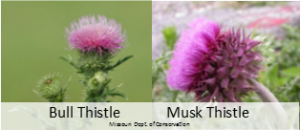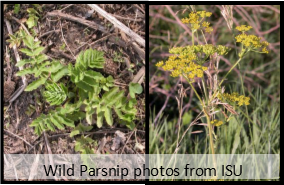There are a lot of unwanted shrubs, trees, and weeds that grow up on properties. It can be difficult to stay ahead of them, especially on ground that you may not visit often. Whether the ground is in CRP or just a property that you don’t get to often, make sure you evaluate it for unwanted plants before they become a nuisance and management becomes significantly more difficult. If you have weeds or trees/shrubs to manage on CRP during the nesting season, May 15-August 1, you will need to request permission from FSA to treat these areas unless it is during the first 2 years of the CRP establishment.
Woody plant management
There are many methods for controlling woody species, however some methods are more effective on specific species than others. If simply cutting woody species (called mechanical control), many young deciduous trees and shrubs will resprout. Conifers will not resprout after cutting. Younger trees are more apt to resprout than older trees. The greatest degree of sprouting occurs when trees are cut while dormant (late fall and early spring) and least if they are cut after full leaf expansion. Often, it is advised to combine mechanical control with chemical control to have the most effective management.
When applying chemicals, make sure to follow the label guidelines and restrictions. Sites are classified as cropland (grazing or crop ground) or non-cropland. Most chemicals have specific restrictions on grazing land. When two or more products are combined, the longest grazing restriction must be followed.
There are several methods for applying chemicals including 1) foliar sprays; 2) basal spray – spraying the lower 18” of the tree trunk; 3) cut-stump – spray the stump after mechanical cutting; 4) Hack-n-squirt – chemical applied to ax-cuts around base; 5) hypohatchet injection; and 6) soil application. More detailed information about all of these methods and treatment suggestion for specific species can be found in this ISU article. The most common methods of control in this area are foliage sprays, which are often used on multiflora rose, and cut-stump where a tree/shrub is cut and then chemical is applied to the outer edge (sapwood-cambium area) within the first 30 minutes of cutting.
Below are suggestions for how to manage specific weed species.
Multiflora Rose
Cultural control of multiflora rose can be achieved by promoting growth of desired species to outcompete the multiflora rose. Avoid overgrazing pastures and frequently mow other non-crop areas to prevent multiflora rose seedlings from becoming established. Herbicidal control is commonly used for management. Plants that are mowed should be sprayed as well to prevent resprouting. Allamakee County even provides 25% cost-share for the chemical used. Just bring a copy of your bill to the NRCS/SWCD office and mark out on a map the area that is being treated. The SWCD will send the bill and map to the courthouse and the cost-share will be mailed directly to you. Foliar applications are common, but work best just after peak bloom in the early summer, just after the white blooms fall off and the plant is at its weakest. Some of the common chemicals include Escort, Garlon, Crossbow, 2,4-D,and Grazon. Dormant applications can be made in late winter or early spring prior to leafing out. Dormant treatment reduces risk of nontarget injury, but make sure the herbicide you intend to use will work well for that method of application. Basal bark application involves thoroughly wetting the crown and lower 12-18 inches of the stems. Diesel fuel or soil is used to help the herbicide penetrate through the bark. This method is used on dormant plants with dry bark. It is important to re-evaluate the multiflora rose stand to retreat as needed.
Penn State – Multiflora Rose Control
University of Wisconsin – Multiflora Rose Control
ISU – Multiflora Rose and Its Control
Ohio State – Multiflora Rose Control
It is very important to learn to identify wild parsnip. If the juice from the plant comes in contact with skin in the presence of sunlight, a rash and blistering results. This can be very painful, like a burn. It doesn’t matter if the plant is flowering or not, so learn to identify it in both stages. If in contact with parsnip, wash off as soon as possible and wear long sleeves and pants to minimize contact with the plant. Parsnip plants flower from May to July with broad, yellow flower clusters that are 2-6” wide on a stout, grooved stem of 2-5’ in height. The leaves are alternate and have 5-15 leaflets that are sharply-toothed or lobed at the margins.
Mechanical removal of plants by hand pulling or repeated mowing before the plant has seeds set can be effective methods of control, as long as safety precautions are taken to minimize likelihood of skin contact. Chemical control with glyphosate or 2,4-D, among others, can work if spraying in early spring or late fall.
Univ. of Wisconsin – Wild Parsnip
ISU – Wild Parsnip – a weed to watch
Minnesota DNR
Canada thistle is different from some of the other thistle species because it is perennial rather than biennial spreads primarily through vegetative rootstocks rather than seed, making management difficult. The flowers are small (3/4 inches) and flask shaped.They tend to grow in patches and are often difficult to manage in pastures. They are not tolerant of shade, therefore it is important to not overgraze a pasture and to have a good stand of desirable forage species. Management may involve rotational grazing, changing stocking rates, fertilization, and interseeding.
Herbicide control is often done with chemical containing picloram (Tordon) or clopyralid (Stinger). Canada thistle shoots are relatively easy to kill with herbicides, but the extensive root system is more difficult to manage. A study done in Iowa found that with Tordon, Canada thistle control was improved when the herbicide was allowed to contact both the foliage and the soil, whereas with Stinger, foliar applications alone provided adequate control. Keep in mind that because Tordon is very mobile in the soil, you need to be aware of restrictions when using this product to avoid movement offsite through runoff water.
Penn State – Canada Thistle Management
Univ. of Wisconsin – Canada Thistle Management
 Biennial thistles (Musk and Bull thistles)
Biennial thistles (Musk and Bull thistles)
Biennial thistles require two years to complete their life cycle and only reproduce by seed. In the first year, the plant forms a cluster of leaves (rosette) at the soil surface. Flowers are produced the second year and the plant dies in late summer or early fall after seeds have matured. Musk thistle is the most prevalent of the biennial thistles and can be recognized by smooth leaves with silvery margins and a white midrib. The flowers are large (1 ½ – 2 inches diameter) and droop, which is why they are sometimes referred to as nodding thistles. Bull thistles have prominent, sharp spines on each of the leaves pointed lobes and the flowers are gumdrop shape. Thistle seeds are transported by birds.
The most effective control of biennial thistles is to promote vigorous growth of desired vegetation. This can be accomplished through fertilization, avoiding overgrazing, and interseeding additional species to enhance competition. The thistles can be mowed after flowers have grown but before seeds have set to prevent seed production. At least 2 mowings in a summer would be required to eliminate seed production. Chemical control is most effective in the rosette stage, so application should be made in the fall or early spring. Effective options for herbicides include 2,4-D, Grazon, Curtail, and Milestone.
Biennial thistles of Iowa
The Short Story on Thistle Management for Iowa County Pastures


